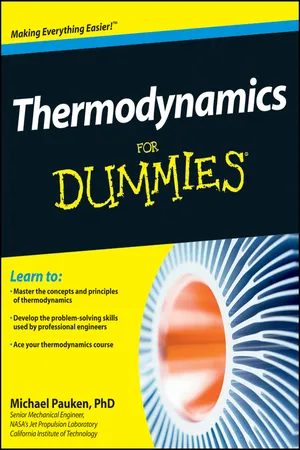Chapter 1
Thermodynamics in Everyday Life
In This Chapter
Seeing thermodynamics in the world around you
Changing energy from one form to another
Getting energy to do work and move heat for you
Figuring out relationships, reactions, and mixtures (nothing personal)
Inspiring you to save the world from an energy shortage
Thermodynamics is as old as the universe itself, and the universe is simply the largest known thermodynamic system. When the universe ends in a whimper and the total energy of the universe dissipates to nothingness, so will thermodynamics end.
Broadly speaking, thermodynamics is all about energy: how it gets used and how it changes from one form to another. In many cases, thermodynamics involves using heat to provide work, as in the case of your automobile engine, or doing work to move heat, as in your refrigerator. With thermodynamics, you can find out how efficient things are at using energy for useful purposes, such as moving an airplane, generating electricity, or even riding a bicycle.
The word thermodynamics has a Greek heritage. The first part, thermo, conveys the idea that heat is somehow involved, and the second part, dynamics, makes you think of things that move. Keep these two ideas in mind as you look at your world in terms of the basic laws of thermodynamics. This book is written to help you understand that thermodynamics is about turning heat into power, a concept that really isn’t so complicated after all.
Grasping Thermodynamics
Many thermodynamic systems are at work in the natural world. That sun you see in the sky is the ultimate energy source for the earth, warming the air, the ground, and the oceans. Huge masses of air move over the earth’s surface. Giant currents of water swirl in the oceans. This movement and swirling happens because of the transformation of heat into work.
Energy takes many different forms — it can’t be created or destroyed, but it can change form. This statement is one of the fundamental laws of thermodynamics. Consider how energy changes form in storm clouds:
- Storm clouds have motion within them.
- Motion between moisture droplets in clouds rubbing against each other creates friction.
- Friction causes a buildup of static charge.
- When the charge becomes high enough, the clouds produce lightning.
- This electrical surge of energy can then start a fire on the ground, and before you know it, you have a combustion problem on your hands.
Not only does energy change form, but matter (that is, a material or substance) also changes form in many thermodynamic systems. Storm clouds are formed by water evaporating into the air. As the water vapor reaches the colder parts of the atmosphere, it condenses to form clouds. Eventually, the amount of moisture the clouds contain becomes great enough to collect into droplets and form liquid water again, so it rains.
One thing people have observed about energy is that it flows in a preferred direction. This observation is another fundamental law of thermodynamics. Heat flows from a hot object to a cold object. Wind blows from a region of high pressure to a region of low pressure. Some forms of energy are developed by forces of nature. Air bubbles move upwards in water against gravity because buoyancy forces them to rise. Water droplets fall in the atmosphere because the force of gravity pulls them toward the ground.
Another brilliant observation about energy is that if you have absolutely no energy at all, you have no temperature. The concept of absolute zero temperature is a fundamental law of thermodynamics.
I cover the changing forms of energy and matter and the fundamental laws that govern how these changes work in Part I.
Examining Energy’s Changing Forms
Many clever people have observed the fundamental laws of thermodynamics in natural systems and applied them to create some wonderful ways of doing work by harnessing energy. Heat is used to generate steam or heat up air that moves a piston in a cylinder or spins a turbine. This movement is used to turn a shaft that can operate a lawn mower; move a car, a truck, a locomotive, or a ship; turn an electric generator; or propel an airplane.
Other clever people have used thermodynamic principles to use work to move heat from one place to another. Refrigerators and heat pumps remove heat from one location to produce a desirable cooling or heating effect. The work required for this cooling shows up on your electric bill every month.
In Part II, I show you how the fundamental laws of thermodynamics can tell you how much heat you need to provide to produce work that can be used to move a car, fly an airplane, or turn an electric generator. You can also use the laws of thermodynamics to find out how efficient something is at using energy.
Energy is the basis of every thermodynamic process. When you use energy to do something, it changes form along the way. When you start your car, the battery causes the starter to turn. The battery is a big, heavy box of chemical energy. The battery’s job is to change chemical energy into electrical energy. An electric motor rotates (a form of kinetic energy) the engine, and the spark plugs fire. These sparks ignite fuel via a combustion process wherein the chemical energy from gasoline is turned into a form of thermal energy called internal energy. In the few seconds it takes to start your car, energy changes from chemical to electrical to kinetic to thermal or internal energy.
Kinetic energy
A car battery provides electricity to operate your starter. As the motor turns, the electrical energy is converted into a form of mechanical energy called kinetic energy. Kinetic energy involves moving a mass so that it has velocity. The mass doesn’t have to be very large to ha...






